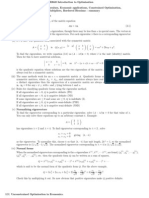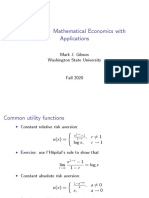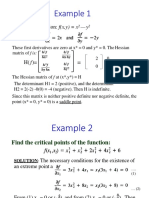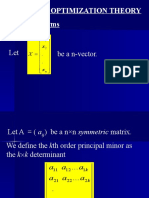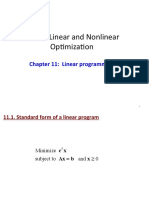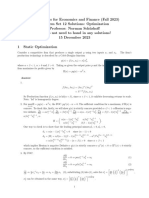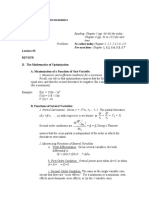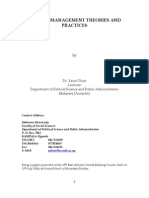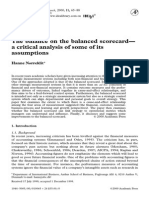A few more past exam questions
(Multiple Choice)
Mark (at most) one answer per question. Choose the answer you find most appropriate.
There is +2 for a correct answer and -1/2 for a wrong (and multiple) answer(s).
In optimization problems with equality constraints:
a the number of constraints equals the number of choice variables.
b the number of constraints may equal the number of choice variables.
c the number of constraints must exceed the number of choice variables.
d the number of constraints may exceed the number of choice variables.
e the number of constraints must be smaller than the number of choice variables.
In optimization problems with inequality constraints:
a the number of constraints equals the number of choice variables.
b the number of constraints may equal the number of choice variables.
c the number of constraints must exceed the number of choice variables.
d the number of constraints must be smaller than the number of choice variables.
e the number of choice variables must be larger than the number of constraints.
In optimization problems with inequality constraints, a sufficient set of conditions
for the existence of a maximum is:
a f (.) convex and g(.) convex.
b f (.) convex and g(.) concave.
c f (.) concave and g(.) convex.
d f (.) concave and g(.) concave.
e nothing of the above.
1
� In optimization problems with inequality constraints, a sufficient set of conditions
for a local maximum to be a global maximum is:
a f (.) convex and g(.) convex.
b f (.) convex and g(.) concave.
c f (.) concave and g(.) convex.
d f (.) concave and g(.) concave.
e nothing of the above.
In optimization problems with inequality constraints, the value of the Lagrange
function, in an optimum:
a equals the value of the objective function.
b may be smaller than the value of the objective function.
c is always smaller than the value of the objective function.
d may be greater than the value of the objective function.
e is always greater than the value of the objective function.
In optimization problems with inequality constraints, the Kuhn-Tucker conditions
are:
a sufficient conditions for (x0, ..., xN ) to solve the optimization problem.
b necessary conditions for (x0, ..., xN ) to solve the optimization problem.
c sufficient but not necessary conditions for (x0, ..., xN ) to solve the optimization
problem.
d neither sufficient nor necessary conditions for (x0, ..., xN ) to solve the optimiza-
tion problem.
e none of the above.
Consider a square matrix M . If the determinant of M is zero, then:
a M is a symmetric matrix.
b the rows of M add up to zero.
c the sum of eigenvalues of M equals zero.
d one row is linearly dependent of the other rows of M .
e M is nonsingular.
2
� If e is an eigenvalue of matrix M , then:
a e is real valued.
b e equals the trace of M .
c ex = M · I
√
d e = 2−1 {tr2 ± tr − 4det}
√
e e = 2−1 {tr ± tr2 − 4det}.
If e1 and e2 are the eigenvalues of a 2 × 2 matrix M , then:
a det M = e1 e2.
b det M = e1 + e2.
c det M = e1 − e2.
d trace M = e1 e2.
e trace M = e1 − e2.
Consider the Hessian, H, of f (x1, x2). If f (x1, x2) is concave, then the eigenvalues
of H are as follows:
a e1 ≥ e2 ≥ 0.
b e1 ≤ 0, e2 ≤ 0.
c e1 ≥ 0, e2 ≤ 0.
d e1 ≤ 0, e2 ≥ 0.
e e1 < 0, e2 > 0.
John’s preferences for two goods, x and y, are given by: u(x, y) = x + a ln(y),
where a > 0. The prices of the two goods are: px > 0, py > 0. Let I > 0 be John’s
income, where I < a px. Calculate John’s utility maximizing quantities x∗, y∗. By
employing the Kuhn-Tucker conditions, check whether or not the following possible
results are true. Indicate your results in the table below.
(a) x =y =0 true O false O
(b) x > 0, y > 0 true O false O
(c) x = 0, y > 0 true O false O
(d) x > 0, y = 0 true O false O
(e) x∗ = y∗ =
3
� Consider u(x, y) = x + a ln(y), with a, x, y > 0. Calculate the Hessian of u(x, y).
Calculate the eigenvalues of the Hessian. Then:
(a) e1 = 0 e2 = 0 true O false O
(b) e1 < 0 e2 > 0 true O false O
(c) e1 < 0 e2 = 0 true O false O
(d) e1 > 0 e2 < 0 true O false O
(e) e1 > 0 e2 = 0 true O false O
Cramer’s Rule [15]
Let an economy be given by the following functions and identities: C = C0 +c Y (1−τ ),
I = I0, G = τ Y , Y = C + I + G. The variables have the usual meaning. Endoge-
nous variables: C (aggregate consumption), Y (GDP), I (investment), G (govern-
ment expenditures). Exogenous variables: I0 (exogenous investment level), C0
(autonomous consumption). Parameters: c (marginal propensity to consume), τ
(income tax rate).
(a) Use Cramer’s rule to calculate C and Y . [5]
C = ..............................................
Y = ..............................................
(b) For almost all parameter values, we can calculate a unique solution for (C, Y ).
Under which parameter restrictions is the solution for (C, Y ) not unique? [10]
Parameter restriction 1: ..............................................
Parameter restriction 2 (if any): ..............................................
Eigenvalues [15]
A Silicon Valley firm produces an amount y of computer chips, of which a percentage
of σ is good and can be sold at a price of p. However, a percentage of (1− σ) of
the produced chips comes with problems — so that they cannot be sold. Suppose,
the firm cannot only control its production level, but the quality of its production, as
measured by σ, as well. A rise in quality (a higher percentage of good chips), however
is costly. Suppose the total cost function is:
β
c(y, σ) = α y + y2 + γ σ .
2
(a) Derive the profit function of the firm.
4
�π(y, σ) = ..............................................
(b) Derive the eigenvalues, (e1, e2) of the Hessian matrix of π(y, σ).
e1 = ..............................................
e2 = ..............................................
(c) Is π(y, σ) concave (convex)?
π(y, σ) is: ........................................................
Minors & Concavity [10]
Consider the following function: f (x1, x2) = ln[a xα] + ln[xβ] + b, where x1 > 0,
1 2
x2 > 0. Using leading principal minors, derive parameter restrictions that guarantee
strict concavity of f (x1, x2).
Parameter restriction 1: ..............................................
Parameter restriction 2 (if any): ..............................................
The following vector-/matrix-multiplication — (a b) — is not defined:
Q dimension of a: n × 1; dimension of b: 1 × n.
Q dimension of a: k × 1; dimension of b: 1 × n.
Q dimension of b: n × 1; dimension of a: 1 × n.
Q dimension of b: n × k; dimension of a: h × n.
Q dimension of b: m × n; dimension of a: m × n.
5
�Consider x = (2, 2, 2), and y = (1, 1, 1). If we project y (orthogonal) onto x, the
projection is t x, where:
Q t = 1.
Q t = 2.
Q t = 1/2.
Q t = 1/3.
Q t = 3.
Consider a nonlinear programming problem. The complementary slackness condition
says:
∂ L(λ,x)
Q ∂ xi ƒ= 0 implies xi ƒ=
∂ L(λ,x)
0.Q ∂ xi = 0 implies xi ƒ=
∂ L(λ,x)
0. Q ∂ xi = 0 implies xi =
∂ L(λ,x)
0. Q ∂ xi ƒ= 0 implies xi
∂ L(λ,x)
= 0. Q
∂ xi = 0 implies xi
< 0.
The famous (Euclidean) norm of x = (2, −2, 3) is:
Q ǁxǁ = 17.
Q ǁxǁ = 25.
Q ǁxǁ = 3.
Q ǁxǁ = 4.
Q nothing of the above.

